10 Species of Hawks in Colorado (With Pictures)
Last Updated on
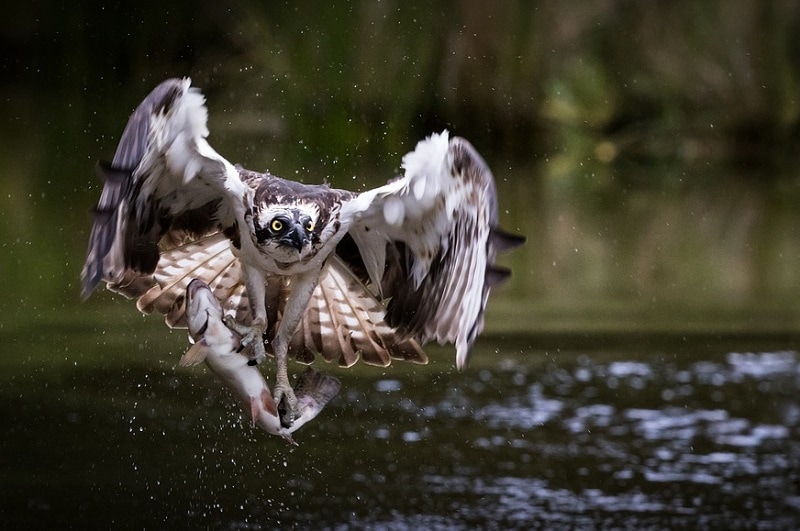
Did you know we have 25 different hawk species in the United States? Of course, you might not get the opportunity to see every single one of them, but if you’re a Colorado resident, you could come across 10 of them.
Would you like to know what they look like, feed on, and nesting behaviors? Well, pull up a chair, and start taking notes.

Hawks in Colorado
1. Cooper’s Hawk
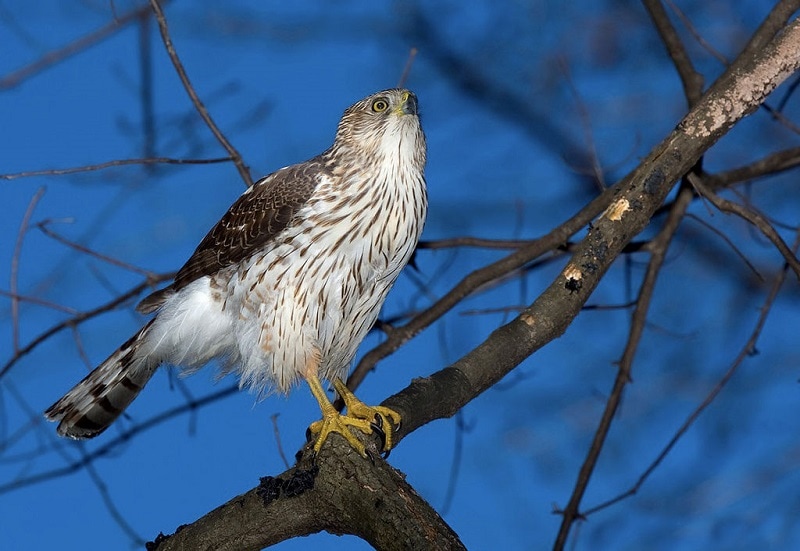
Identifying a Cooper’s hawk can be difficult, especially if you don’t know what to look for. Take the size of the female Sharp-shinned hawk and that of the female Cooper’s hawk, for example. Even though people assume that they’re of the same size, if you put them next to each other, you’ll realize the Sharp-shinned hawk is much smaller in size.
Their body colors are also somewhat different. Both of them have dark colors on top of their heads and red-brown feathers covering their underbellies. However, for the Sharp-shinned hawk, that dark color extends to the neck and all the way down to its back.
Concerning range, Cooper’s hawks have mostly populated North America. They prefer deciduous woodlands, and often hunt small mammals and birds. Their method of hunting is pretty simple.
You’ll see them perched on a tree—like a statue—waiting for prey that’s oblivious to its presence. And once it spots its next meal, it will swiftly swoop down and strike using its powerful talons. If the prey is still alive, it will drag it to some nearby watering hole and drown it.
A female Cooper’s hawk can lay up to 6 eggs a year. And during this breeding season, it will be the male’s responsibility to find, build, and defend the nest. Do you want to learn a fun fact? Even though the female Cooper’s hawk lays eggs every year just like all the other species, it usually does so on the same day. So, if it laid the eggs on the 4th of July this year, next year it will still lay eggs on that same date.
2. Ferruginous Hawk

Does the Ferruginous Hawk fit the Buteo profile? Yes, it does. Why, you ask? First off, judging by appearances along you can obviously tell it’s a hawk. Secondly, it’s as aggressive as they come. And lastly, it’s wings are long and broad, ipso facto, well adapted to soaring.
You have to know your birds to be able to identify this one because it can easily be passed off for an eagle. Yes, it’s rusty back and wing color will be a dead giveaway, but what if you’ve never seen Ferruginous Hawk before? Truth be told, it really does exhibit the same eagle-like qualities as the golden eagle.
Other than its spectacular 4.7-foot wingspan, it also has a large beak and a long gape—A feature that helps it regulate body temperature, in addition to increasing its panting efficiency.
In general, hawks love habitats that have prominent perches. And the Ferruginous Hawk is no different. If it’s not soaring up in the sky, it’s perched somewhere in a desert with short vegetation, stalking its prey. But if the area is populated by humans, you’ll see them perched on top of power-line poles or fence posts.
When it comes to food choices, it’s known to be flexible. Its diet will mainly consist of prairie dogs, rabbits, and any other type of small mammal that you could think of. At the same time, it also feeds on insects, amphibians, and reptiles.
Just like most of the other Buteo family members, it will use the ‘sit and wait’ technique of hunting. And in case you haven’t realized by now, members of this family find this method effective and efficient.
In a season, the female Ferruginous Hawk will lay 3 to 5 eggs. During incubation, the male will be responsible for bringing in food until the eggs hatch. And just so you know, that nest will be the nest used in the next breeding season. They’ll only abandon it if they feel threatened in any way. Ferruginous hawks are very sensitive to any kind of disturbance, so even the presence of humans can force them to abandon their territories.
3. Northern Goshawk

One word to describe the Northern Goshawk? Fierce.
It’s also the largest bird in the Accipiter family, and often found in the northern temperate regions. A Northern Goshawk has red eyes, white eyebrows, and a gray face. It will feel most comfortable in a mature forest, and when the time’s right, you’ll see it build a nest on top of the largest tree found in that particular habitat.
Some birders prefer the nickname the Hunter of the Forest. And yes, they’re that good. If you wish to witness firsthand what they’re capable of, just visit one of their hunting grounds, which happens to be an open understory that’s free of bush.
Like most birds of prey, the Northern Goshawk feeds on small mammals and birds. That’s why you’ll see it trying to wrestle and overpowering a chipmunk, squirrel, or even a crow.
A female Northern Goshawk usually lays 2 to 4 eggs in a season. However, the reproductive potential of this species has significantly reduced, because fishers are preying upon the eggs. Or at least that’s what researchers believe.
And they might be right. Because if you look at the statistical data collected in the late 70s and early 80s, you’ll clearly see a nest used to produce an average of 2.3 fledged young ones annual. Fast forward to the 90s, that number drops to 1.3, while the fisher population almost doubles the original number.
Climate change is another reason why this species is constantly being pushed to the brink. The Northern Goshawk doesn’t really do well in warm climates. So if those temperatures keep on going up, the breeding range will continue to drop.
4. Rough-legged Hawk
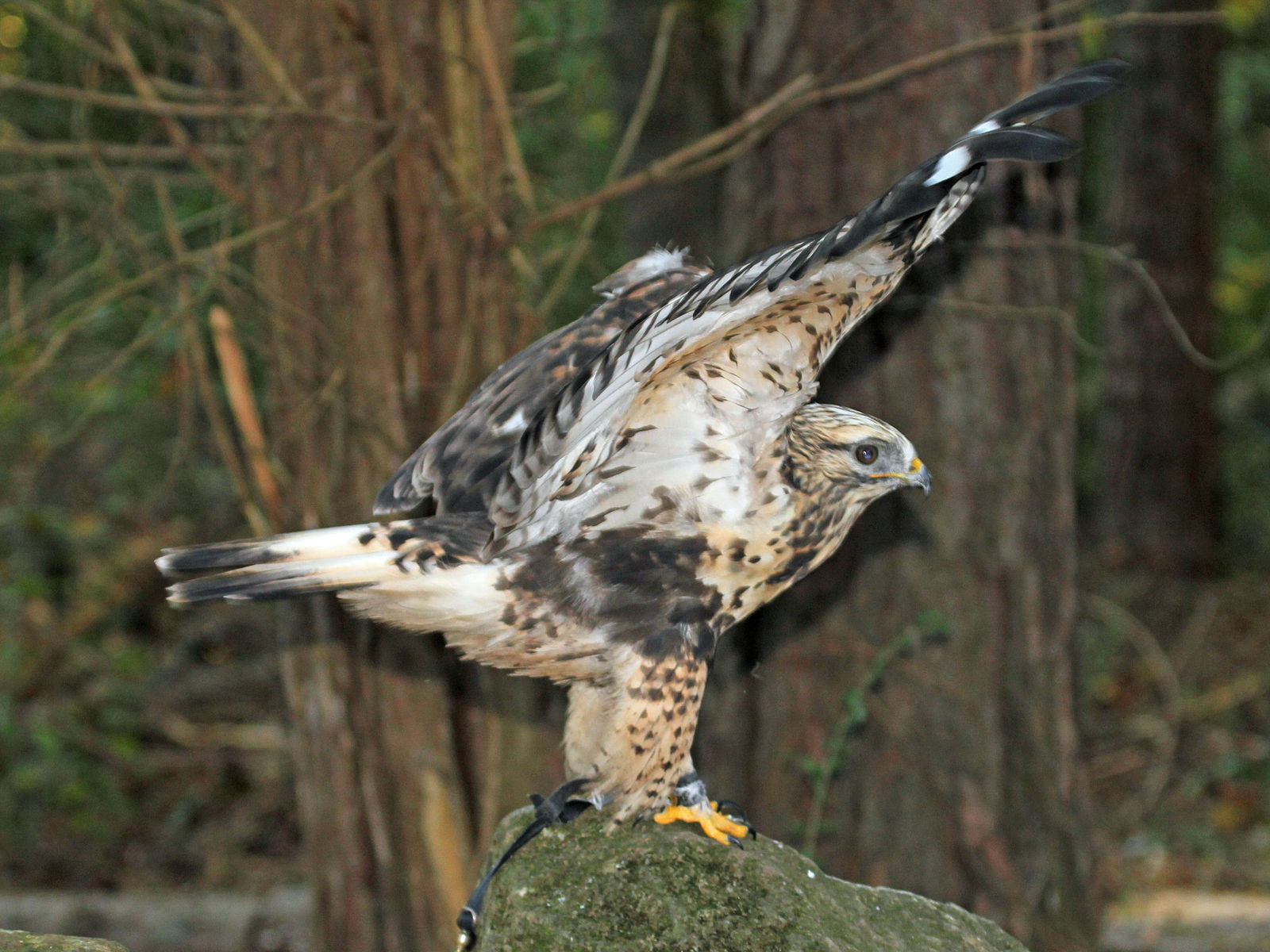
The Rough-legged Hawk is a Buteo family member, and probably the blockheaded one in that family. That’s because it’s the only Buteo soaring hawk that finds cold climates cool—No pun intended.
You’ll rarely see them migrate, even during winter, and when they do, it’s most definitely on account of the fact that lemmings are no longer easily accessible. So, if the lemmings population goes down, they’ll have to look for new breeding grounds, and source of food.
Most of its population is found in the tundra regions, on the northern side of the boreal forest. The most distinguishable trait is the feathering that you’ll see extending down its legs to the toes. As a matter of fact, this feature is the reason why it’s called “Rough-legged.” An adaptation that helps it stay warm in that cold weather.
The Rough-legged hawk mostly feeds on rodents. You might also find it feeding on small birds, mammals, frogs, and even insects. Voles and lemmings are the main diet during summer, or when they’re breeding.
Speaking of, the female Rough-legged hawk will lay 3 to 5 eggs a year. But if the food is in abundance, they’ll lay up to 6 eggs. The eggs are pale bluish-white and they’re to be incubated for about 31 days. During that period, the male will bring food and take over the incubation duties while the female feeds.
5. Osprey

What are its distinctive features? It has narrow wings, black and white body color, long legs, and M-shaped flight silhouette.
The Osprey is a common hawk species, as it’s found on all continents save for Antarctica. Ever heard of the ‘fish hawk’? No? What about the ‘sea hawk’? Yup, it’s the same bird. It has this tendency of hanging around coastlines, and that’s what earned it those two monikers.
Only someone who’s well-travelled will know there are four different subspecies of Osprey, and they all differ in size and appearance. The North American population is known to be migratory. During winter most lakes will be frozen, so they’ll migrate south to breed, and search for food.
A young Osprey will migrate with its parents during this period, but return home once the weather changes. They sometimes go back to their birth nest, or just build a different home.
An Osprey’s diet consists of fish. It doesn’t matter what kind or what size. As long as it swims, it’s food. In fact, the way their eyes are structured, they can see anything swimming below when they’re soaring 130 feet in the air.
Their method of hunting is a tad bit different, but also similar in a way. The similarity is in how they stalk the prey. They’ll first sight it, and then stalk it. Once the target’s locked in, they’ll dive feet first into the water, and maybe even submerge entirely.
An Osprey’s nesting behavior is what you’d typically expect given it’s a hawk. They’re naturally monogamous, and usually build bulky nests out of sticks. The Male Osprey will pick the site, but they’ll work together during construction.
The female Osprey lays a maximum of 3 eggs, but they won’t hatch at the same time. And now you know why some chicks always look bigger or more dominant even though the eggs were laid during the same breeding season.
6. Sharp-Shinned Hawk

As mentioned earlier, identifying or differentiating this species from the Cooper’s hawk won’t be a walk in the park. If you can’t tell which bird is which based on their body color, pay close attention to its general size. A Sharp-shinned hawk will be smaller than a football, and the legs will be longer.
Often referred to as the ‘Sharpie,’ this species happens to be the smallest of the hawk family. What genus of birds do they belong to? Accipiters. And you’ll find them hanging around parks, or in the wild. In hindsight, if we had to pick one stealth bomber in that family, we would certainly pick this one.
“Timing” is not a concept that they’re familiar with. They’ll just attack the moment that thought crosses their mind. They’re known to be swift, and will approach any type of unsuspecting prey through a foliage. Oh, and by the way, unlike other species, they don’t pounce from vertical position, but horizontally.
The Sharp-Shinned Hawk is a master at hiding nests. You definitely hear them call each other, but you’ll not be able to see them. Not unless you’re really looking. Also, the female will lay 4 to 5 eggs a year, and incubate them for close to four weeks.
7. Broad-Winged Hawk

Large is certainly not the word that we would use when describing the broad-winged hawk. It’s one of the smallest raptors, but has wide wings that characteristically define a bird of prey. Most of its body parts will feature tints of copper, with a white feathered underbelly.
The broad-winged hawk doesn’t have a specific diet. Hand it the menu and it will pick the usual: insects, small mammals, amphibians, you name them.
In a way, that also means it’s well adapted to snatching prey off the ground using its powerful talons. It rarely hunts on the wing, as most of the time it’s perched at a high point.
Ordinarily, the female lays 2 to 3 eggs and incubates them for close to a month. And as you know, seeing as it’s a bird of prey, the male will ensure it’s well fed during that period.
Once the eggs hatch, the parents will nurse them for 5 weeks before letting them fend for themselves.
8. Northern Harrier

In some books, they’re called the ‘Marsh Hawks.’
The Northern Harrier are known to be birds of open terrain, with distinctive features such as the long tail and long wings. While searching for food, you’ll often see them soaring over marshes and pasture.
And because we’ve been part of their world for quite a long time, we can confidently note that they usually have a distinctive veering flight.
An adult male and female will have different colors. The males are silvery-blue, while their counterparts are dark brown. They’re also slender, incredibly light, and have a wingspan of approximately four feet.
The northern harrier will eat just about anything. Be it insects, small birds, carrion, amphibians, mammals, reptiles, and the list goes on. Something else that we found to be fascinating was the fact that they sometimes roost on the ground. This is a rarity in the hawk family because some predators see hawks as prey. A good example is the red fox.
9. Swainson’s Hawk
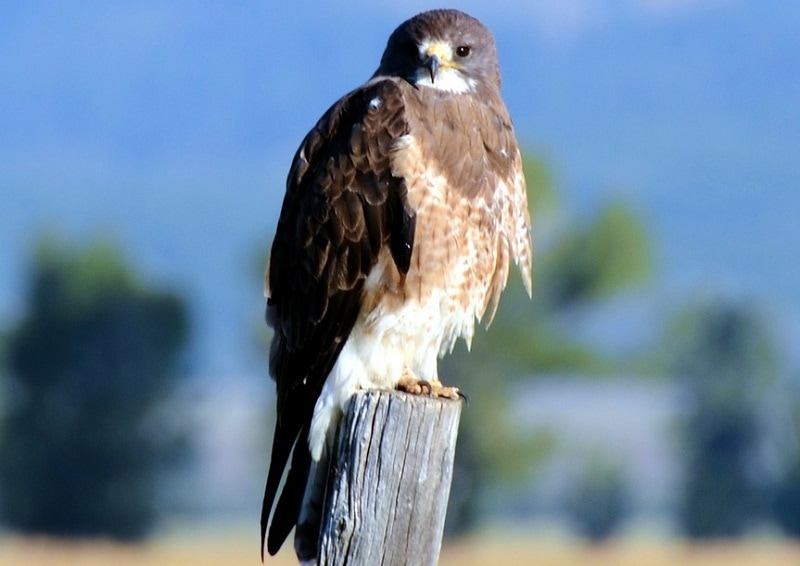
If you’re interested in seeing a Swainson’s Hawk, you can visit any mountainous region in North America or the eastern plains of Colorado. Typical of a hawk, it will either be perched somewhere trying to stalk a prey, or soaring across open prairie.
Together with their other brethrens, they’ll migrate south during winter. That means the best time to spot one would be around June, July, or August. These three months are known as their migratory months.
Even though they aren’t as big as other hawks, they actually do have a considerably large wingspan. And we really can’t be specific with their color patterns because they normally vary. We can however tell you this; if you had to place a bet, bet on their underwings being white.
Rarely will you find a Swainson’s Hawk building a nest. That’s not their MO. They’ll instead steal nests from other hawks, and pretend that has always been their home. When it comes to hunting, they do so in flocks. Or you could call them “Kettles,” if you’re trying to come across as someone who’s educated in the field.
10. The Red-Tailed Hawk
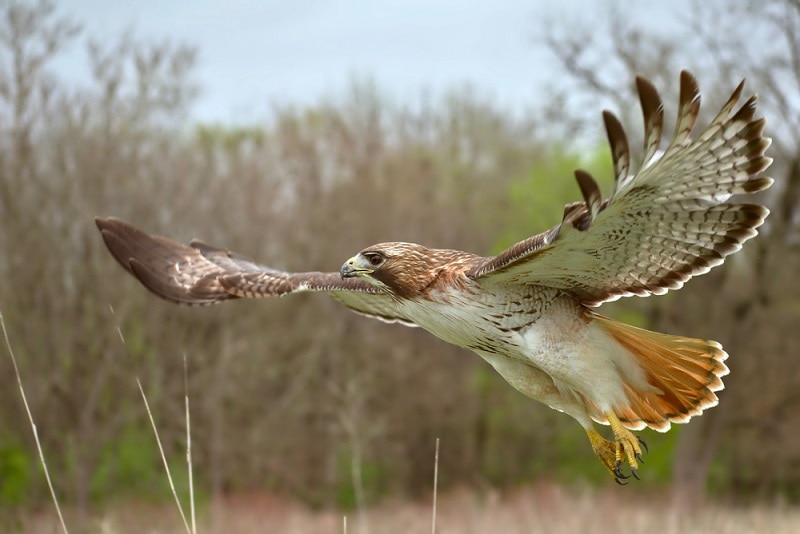
We decided this was going to be our last raptor because it’s pretty common in North America. If you dare tell us that you’ve never seen a red-tailed hawk before then we’ll right away assume you were frozen cryogenically in the 40s—like what they did to Captain America—and they just woke you up. It’s either that or you’ve been living under a rock all this time.
Moving on, this species is commonly known as the red-tailed because when it’s fully fledged, the tail develops a rusty-red color. This color usually starts to show after two years. But before it gets to that stage, the tail will just show some banding.
Back in the day, red-tailed hawks only used to breed, feed, and hunt in the wild. But as the human population grew, their habitats were encroached upon forcing them to find a way to survive within our communities.
Today you’ll see them perched on power line poles, scanning for potential prey. And for the record, “potential prey” in this context includes that meat that you’ll be roasting for family and friends during cookouts.

Protection Status
Now that you know the kind of hawk species found in Colorado, it’s time to learn why shooting or even owning a hawk is considered illegal in the United States.
Birds fall under different categories, and the hawk happens to fall under the “raptor category.” We’re sure you know this by now. What you might not know, is the vital role that this species plays in an ecosystem.
There’s a food chain in every ecosystem, and in a food chain, we always have the ultimate predator. In our ecosystem, the hawk is regarded as the top dog. And in the middle of that chain, you’ll find animals such as rabbits, squirrels, and other small birds. At the very bottom, there’s the habitat.
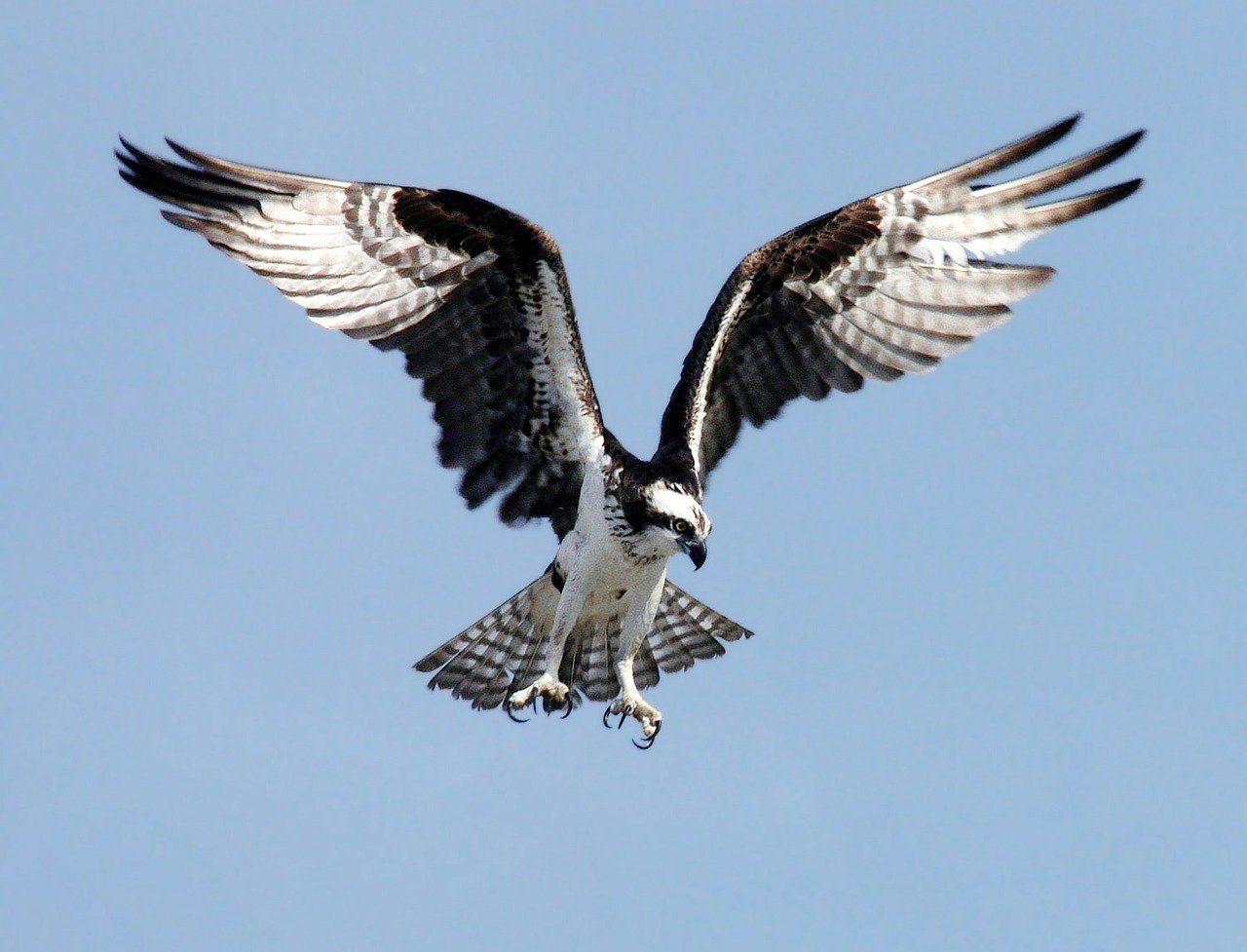
If you try to eliminate the predator that’s at the top of this food chain, the entire system will fall out of balance. The population of the animals in the middle will exponentially increase and the habitat at the bottom won’t be able to sustain the numbers. Basically, what we’re saying is, there will be a chain reaction that will spell doom for every living creature on the planet.
The U.S. government knows this, and that’s why it implemented the Federal Migratory Bird Treaty Act. A treaty that makes it illegal to kill, hunt, or even own any species of the hawk family.

In Conclusion
And that brings us to the end of today’s piece on the different species of hawk in Colorado. But before signing off, we would like you to know some states offer permits to residents who are willing to help raise awareness and protect all these different species from going extinct. So, if you’re interested, or if you have any questions, reach out to the U.S. Fish and Wildlife Service.
If you want to learn more about birds, check out some of our other posts:
- 10 Species of Cardinal Birds
- 10 Proven Ways to Attract Hummingbirds to Your Yard & Feeders
- How to Use a Spotting Scope for Birding (4 Helpful Tips)
- 20 Types of Duck in Colorado
Featured Image Credit: IainPoole, Pixabay
About the Author Robert Sparks
Robert’s obsession with all things optical started early in life, when his optician father would bring home prototypes for Robert to play with. Nowadays, Robert is dedicated to helping others find the right optics for their needs. His hobbies include astronomy, astrophysics, and model building. Originally from Newark, NJ, he resides in Santa Fe, New Mexico, where the nighttime skies are filled with glittering stars.
Related Articles:
Monocular vs Telescope: Differences Explained (With Pictures)
How to Clean a Refractor Telescope: Step-by-Step Guide
How to Clean a Telescope Eyepiece: Step-by-Step Guide
How to Clean a Rifle Scope: 8 Expert Tips
What Is a Monocular Used For? 8 Common Functions
How to Clean a Telescope Mirror: 8 Expert Tips
Brightfield vs Phase Contrast Microscopy: The Differences Explained
SkyCamHD Drone Review: Pros, Cons, FAQ, & Verdict
